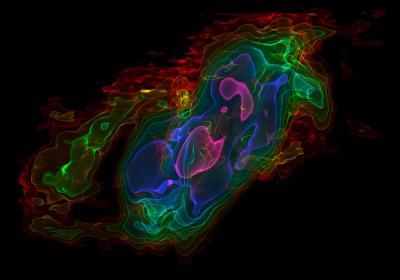Galaxies — systems like our own Milky Way that contain up to hundreds of billions of stars — are the basic building blocks of the cosmos. One ambitious goal of contemporary astronomy is to understand the ways in which galaxies grow and evolve, a key question being star formation: what determines the number of new stars that will form in a galaxy?
The Sculptor Galaxy, also known as NGC 253, is a spiral galaxy located in the southern constellation of Sculptor. At a distance of around 11.5 million light-years from our Solar System it is one of our closer intergalactic neighbours, and one of the closest starburst galaxies [1] visible from the southern hemisphere. Using the Atacama Large Millimeter/submillimeter Array (ALMA - http://www.eso.org/alma) astronomers have discovered billowing columns of cold, dense gas fleeing from the centre of the galactic disc.
"With ALMA's superb resolution and sensitivity, we can clearly see for the first time massive concentrations of cold gas being jettisoned by expanding shells of intense pressure created by young stars," said Alberto Bolatto of the University of Maryland, USA lead author of the paper. "The amount of gas we measure gives us very good evidence that some growing galaxies spew out more gas than they take in. We may be seeing a present-day example of a very common occurrence in the early Universe."
These results may help to explain why astronomers have found surprisingly few high-mass galaxies throughout the cosmos. Computer models show that older, redder galaxies should have considerably more mass and a larger number of stars than we currently observe. It seems that the galactic winds or outflow of gas are so strong that they deprive the galaxy of the fuel for the formation of the next generation of stars [2].

This picture shows a view of a three-dimensional visualisation of ALMA observations of cold carbon monoxide gas in the nearby starburst galaxy NGC 253 (The Sculptor Galaxy). The vertical axis shows velocity and the horizontal axis the position across the central part of the galaxy. The colours represent the intensity of the emission detected by ALMA, with pink being the strongest and red the weakest.
These data have been used to show that huge amounts of cool gas are being ejected from the central parts of this galaxy. This will make it more difficult for the next generation of stars to form.
(Photo Credit: ALMA (ESO/NAOJ/NRAO)/Erik Rosolowsky)
"These features trace an arc that is almost perfectly aligned with the edges of the previously observed hot, ionised gas outflow," noted Fabian Walter, a lead investigator at the Max Planck Institute for Astronomy in Heidelberg, Germany, and a co-author of the paper. "We can now see the step-by-step progression of starburst to outflow."
The researchers determined that vast quantities of molecular gas — nearly ten times the mass of our Sun each year and possibly much more — were being ejected from the galaxy at velocities between 150 000 and almost 1 000 000 kilometres per hour [3]. The total amount of gas ejected would add up to more gas than actually went into forming the galaxy's stars in the same time. At this rate, the galaxy could run out of gas in as few as 60 million years.
"For me, this is a prime example of how new instruments shape the future of astronomy. We have been studying the starburst region of NGC 253 and other nearby starburst galaxies for almost ten years. But before ALMA, we had no chance to see such details," says Walter. The study used an early configuration of ALMA with only 16 antennas. "It's exciting to think what the complete ALMA with 66 antennas will show for this kind of outflow!" Walter adds.
More studies with the full ALMA array will help determine the ultimate fate of the gas carried away by the wind, which will reveal whether the starburst-driven winds are recycling or truly removing star forming material.
Source: ESO